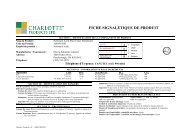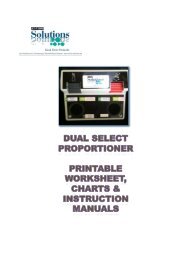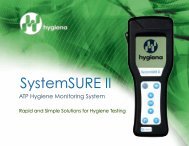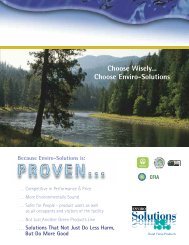Environmental Claims in Consumer Markets Summary Report North America April 2009
Environmental Claims in Consumer Markets - The Sins of ...
Environmental Claims in Consumer Markets - The Sins of ...
Create successful ePaper yourself
Turn your PDF publications into a flip-book with our unique Google optimized e-Paper software.
TM• ‘Organic’, <strong>in</strong> various forms, is the second mostcommon claim <strong>in</strong> this category. It was found on76 baby products and 1 toy. In all cases, these claimswere made <strong>in</strong> reference to materials from which theproduct was made, usually cotton.In the US and Canada, organic claims were supportedby certification on only 21 of these products.Any claim – organic or otherwise – for which there isno readily accessible evidence commits the S<strong>in</strong> of NoProof. More detail on the difficulties with ‘organic’claims is provided <strong>in</strong> the next section, on cosmetics.• ‘BPA-free’ was claimed by 44 baby products and 5toys. None of these products offered any certificationor verification of the claim and consequently all werefound to commit the S<strong>in</strong> of No Proof.A total of 44 products, (36 baby care and 8 toys),used vague environmental statements such as ‘ecofriendly’,‘earth-friendly’, ‘earth-friendlier’, and ‘goodfor the environment’. Without elaboration, these termsare mean<strong>in</strong>gless s<strong>in</strong>ce they are entirely subjective.These claims all commit the S<strong>in</strong> of Vagueness.Cosmetics (Health & Beauty Products)<strong>Consumer</strong> consciousness of the environmental andhealth effects of personal care products –cosmetics, shampoos, and soaps, for example – hasgrown steadily over several decades. High profile retailposition<strong>in</strong>g at stores like the Body Shop hascontributed to this trend.The simple fact that we put these products on (or <strong>in</strong>)our body (products such as toothpaste, shampoos, orlotions) has also contributed to the heightenedconsumer awareness. Most recently, the <strong>in</strong>gredients ofthese products have begun to attract <strong>in</strong>creased scrut<strong>in</strong>yby advocates and regulators.It is little surprise, consequently, that this year’s SevenS<strong>in</strong>s of Greenwash<strong>in</strong>g report isolated health andbeauty products as a prom<strong>in</strong>ent category for greenclaims and greenwash<strong>in</strong>g.Exhibit 6 summarizes the f<strong>in</strong>d<strong>in</strong>gs <strong>in</strong> this category.Some examples of products <strong>in</strong> this category:- ‘biodegradable’ and ‘organic’ cotton swabs- ‘earth-friendly’ sponges- ‘100% natural’ and ‘biodegradable’ kids soaps- ‘100% pure organic’ shampoos and conditioners- ‘all-natural’ hair removal- ‘100% natural’ bronzer- ‘all natural’ and ‘certified oganic’ toothpastes• By far the most common environmental claim <strong>in</strong> thiscategory, found on 263 products, is ‘natural’. Forexample:- ‘naturally pure’ body lotion- ‘naturally-derived’ <strong>in</strong>gredients <strong>in</strong> handsoaps- facial buffs ‘made with natural materials’- ‘naturally refresh<strong>in</strong>g’ soapsUnless a specific def<strong>in</strong>ition is offered, claims of ‘natural’commit the S<strong>in</strong> of Vagueness. The specific challengeswith ‘natural’ claims are described above, <strong>in</strong>the section entitled Kids (toys & babyproducts).263Number of cosmetics claim<strong>in</strong>g to be‘natural’, by far the most commonenvironmental claim <strong>in</strong> this category.www.s<strong>in</strong>sofgreenwash<strong>in</strong>g.org








